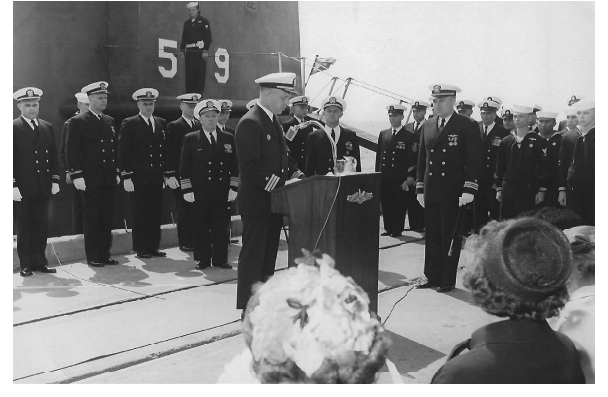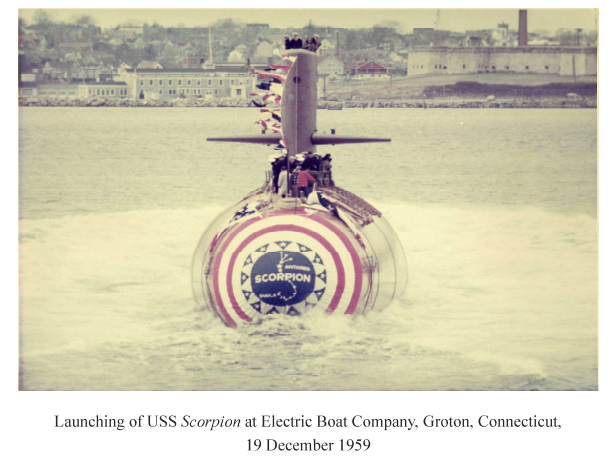I reported to USS Scorpion (SSN-589) as a young ensign straight out of the Academy, nuclear power training and an abbreviated sub school, in August of 1961. Scorpion had recently completed her post shipyard availability. The crew and wardroom were very close, havingjust worked together on new construction testing and operations, and were very familiar with the ship.
Our Captain was Commander Buzz Bessac, who had not moved his family to Norfolk after building at EB, and so lived on board. Captain Bessac assigned his two new ensigns, me and my Naval Academy class mate Jim Patton, to two jobs each, one forward and one in engineering. I got Commissary and Auxiliary Divisions. My mentors were LT Bob Fountain, former Commissary Officer, and our Engineer, LT Buelle Balderston. Additionally, Jim and I both had to qualify as OOD, EOOW, and in submarines.
Scorpion at the time was the latest and greatest in submarines. I had taken my first class midshipman cruise on a diesel boat, USS Sea Cat (SS-399), but this was a whole new experience. Scorpion had the new streamlined Albacore hull, was only 252 feet long, and could maneuver quietly in a fairly tight circle with only five degrees rudder. Her SSW nu clear steam propulsion plant, coupled with an HY 80 hull, opened up high speeds and for then, deep operations.
Captain Bessac loved to demonstrate maneuverability to (usually VIP) riders by having the planesmen stand behind their chairs while changing depths in deep waters using the automatic depth control system. Both planes would immediately swoop into full dive positions like an eagle flapping its wings, and then gradual ly ease off, as the sub almost instantaneously slipped onto its new depth. As I recall, the ship was not submerged from the bridge, as were Nautilus, which had been my sub school boat, and Sea Cat. The OOD and lookouts were brought down to Control Room and submerged from there.
Hull openings were shown as red circles [open] or as straight red lines [closed], not the “green board, red board” panels of Sea Cat. But we still had and used a negative tank. When you flushed a toilet, you did so with sea water at full pressure of the depth of the ship, as were all the sea water systems throughout the ship.
In the day, atmosphere control was not where it is today. One of my early jobs as Auxiliary Division Officer was to work with NAVSEA and a commercial oxygen supplier and do the first loadout of high pres sure oxygen into our large banks. Submerged, this was bled into the ship through reducers to maintain breathable air, or else oxygen candles had to be burned. The CO burners were under sized and had to be continually worked with. The CO2 scrubber worked fine, as did the air conditioners.
My first senior commissaryman was PO2 English, who with one other cook served up four meals a day to the crew and Wardroom. He ordered and supervised the storing of food for two month underways submerged. With the small size of the ship, cases of non refrigerated foods were stacked throughout the passageways forward of the engineering spaces. Cases of eggs were stored in the Torpedo Room bilges for cooling. One time I recall we were extended on patrol to something like 76 days.
My predecessor had loaded an off the books ample supply so that we were in good shape with food for the extension. However, when I brought the commissary returns to the Captain for signature, without a reload ability at sea, I had to reflect accountability for all the stores, which made it look like we did not use all our allowance of dollars.
There was no way I was going to explain this to the Captain! Later in my career, I was most enthusiastic about having Supply Corps officers on board to deal with all commissary matters.
The more senior officers on board mostly had very prominent careers. Bob Fountain made rear admiral. Our first XO, Ken Carr, made vice admiral, and was COMSUBLANT. Buelle Balderston became the skipper of USS Tautog (SSN-639). Jerry Holland also made rear admiral, and our second XO, Carl Trost, made admiral. Our second CO, R.Y. “Yogi” Kaufman, made vice admiral.
While I was on board, Scorpion earned a Navy Unit Commendation. Many of the enlisted crew also went on to successful careers, many making E-8 and E-9, earning commissions as LDOs, and going through college under the Navy Enlisted Scientific Education Program (NESEP) to earn commissions.
Jim Patton and I both qualified in submarines on board, and made LTjg, XO LCDR Ken Carr and navigator LCDR Dick Lumsden moved on to become Blue and Gold Executive Officers of new construction USS James Monroe (SSBN-622), recruiting Jim and me to join them. Jim went on to command USS Pargo (SSN-650) and I went on to com mand USS Tecumseh (SSBN-628).
None of the Chiefs at the time wanted to be Chief of the Boat, so Gunners Mate 1, Wally Bishop volunteered, converted to TMl, and later advancing to CPO. Somehow, he and QMCS Mazzuchi managed to stay with Scorpion and were lost with the ship, with all hands, in 1968. At the time of the loss I was stationed in Madrid, Spain, as an Olmsted Scholar. This year marks 50 years since the loss, and former crewmen and families will commemorate the loss over Memorial Day Weekend in Norfolk. This time I will be able to be in Norfolk to join the families and former shipmates.


The author, CAPT Mark Golden, USN (Ret), served aboard Scorpi on in 1961-1962. He currently is a volunteer Blue and Gold Officer for the U.S. Naval Academy Admissions Office and resides in Bloomsburg, PA.

